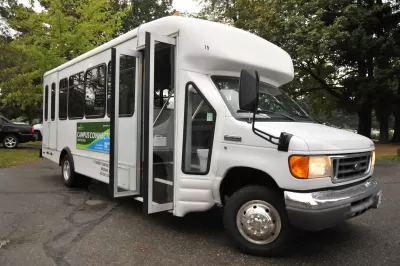The Eno Center for Transportation looks at how on-demand transportation services can set themselves up to succeed, and learn from failed attempts.

A new report from the Eno Center takes a deep dive on microtransit, or small-scale, on-demand public transit systems. As Patrick Sisson writes, "the report analyzed a handful of pilot programs meant to solve the challenges facing urban mass transit: ridership declines, costs and inefficiencies, and insufficient options, especially for resources for underserved communities."
The failures of early trials, including the startup Bridj and the Santa Clara County’s Valley Transportation Authority's FLEX service, "have shown it's better to build on existing services than try to create entirely new systems. Or, in tech vocabulary, try to iterate as opposed to disrupt."
One microtransit attempt that's faring reasonably well is the Alameda-Contra Costa Transit District's Flex (not to be confused with the above FLEX). Eschewing a mobile app, Flex lets users book trips in advance. Pickups occur at city bus stops, but riders don't have to stand and wait. "The AC Transit's Flex system isn't perfect, but the agency found the switch offered faster rides for many customers, and was revenue neutral."
According to the report, AC Transit's Flex system also benefited from extensive marketing and outreach. "The authors found that AC Transit 'knew it had a clear customer base for this line, albeit low density and low demand,' and that by focusing on a specific challenges and customer base, they were able to generate significant ridership."
FULL STORY: Microtransit: How cities are, and aren’t, adapting transit technology

Maui's Vacation Rental Debate Turns Ugly
Verbal attacks, misinformation campaigns and fistfights plague a high-stakes debate to convert thousands of vacation rentals into long-term housing.

Planetizen Federal Action Tracker
A weekly monitor of how Trump’s orders and actions are impacting planners and planning in America.

In Urban Planning, AI Prompting Could be the New Design Thinking
Creativity has long been key to great urban design. What if we see AI as our new creative partner?

King County Supportive Housing Program Offers Hope for Unhoused Residents
The county is taking a ‘Housing First’ approach that prioritizes getting people into housing, then offering wraparound supportive services.

Researchers Use AI to Get Clearer Picture of US Housing
Analysts are using artificial intelligence to supercharge their research by allowing them to comb through data faster. Though these AI tools can be error prone, they save time and housing researchers are optimistic about the future.

Making Shared Micromobility More Inclusive
Cities and shared mobility system operators can do more to include people with disabilities in planning and operations, per a new report.
Urban Design for Planners 1: Software Tools
This six-course series explores essential urban design concepts using open source software and equips planners with the tools they need to participate fully in the urban design process.
Planning for Universal Design
Learn the tools for implementing Universal Design in planning regulations.
planning NEXT
Appalachian Highlands Housing Partners
Gallatin County Department of Planning & Community Development
Mpact (founded as Rail~Volution)
City of Camden Redevelopment Agency
City of Astoria
City of Portland
City of Laramie




























